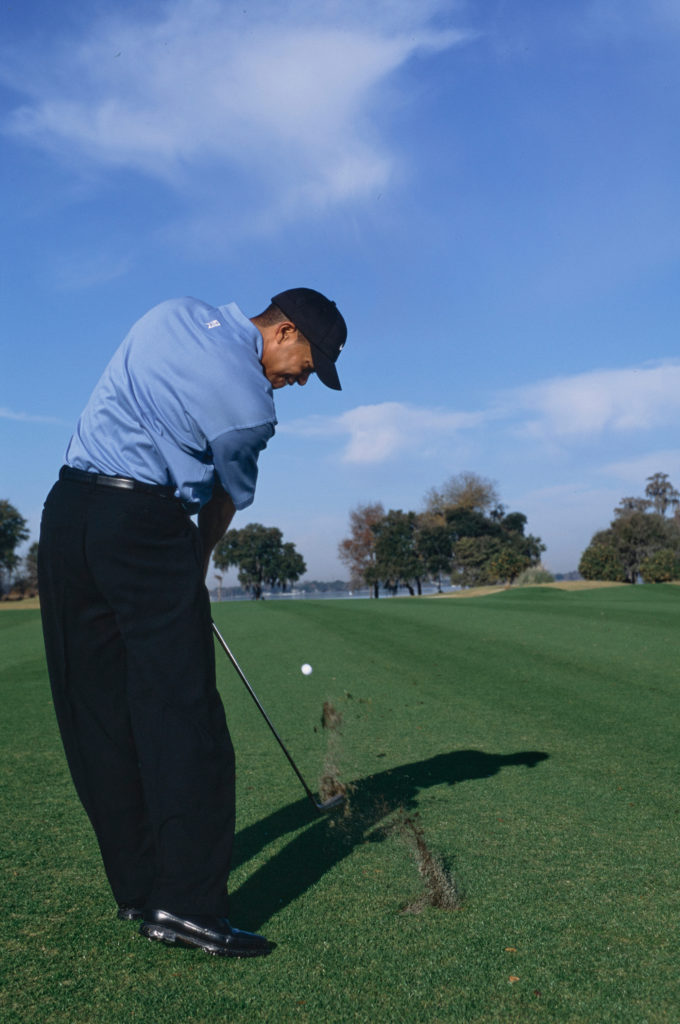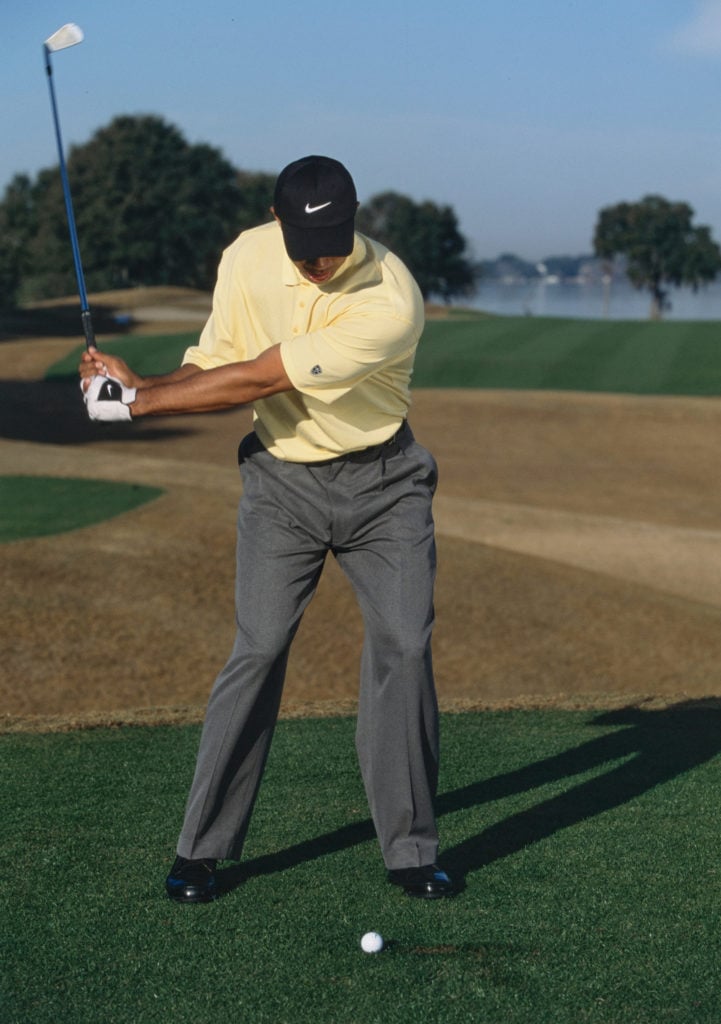Editor’s note: From 1996 when he turned professional to 2005, Tiger Woods won 46 of his 82 PGA Tour victories and 10 of his 15 Major championships. We went back into our archives to cull his thoughts on how he executed various shots during that 10-year span – from bombs off the tee to delicate shots from the fringe. This era was “Prime Tiger”, and how he played the game during that period is timeless advice for average golfers. His abilities might have seemed superhuman, but his thoughts on executing shots were as simple as they were effective. In this article, we have selected some of his most useful tips from previous issues to appreciate from a historical sense – and use the next time you try to channel your inner Tiger. – Ron Kaspriske

Go shoulder to shoulder for power
▶ Tiger says: To launch your tee shots or your fairway woods off the deck, you want to be flexible enough to get your left shoulder under your chin on the backswing [previous page], making a big turn with your upper body while restricting your hips. This allows you to load your right side. The shoulder turn on the follow-through should be just as full, with the right shoulder now under your chin [above] as you finish the swing. Make a full shoulder turn on the backswing and follow-through, and you’ll hit the ball a lot farther.
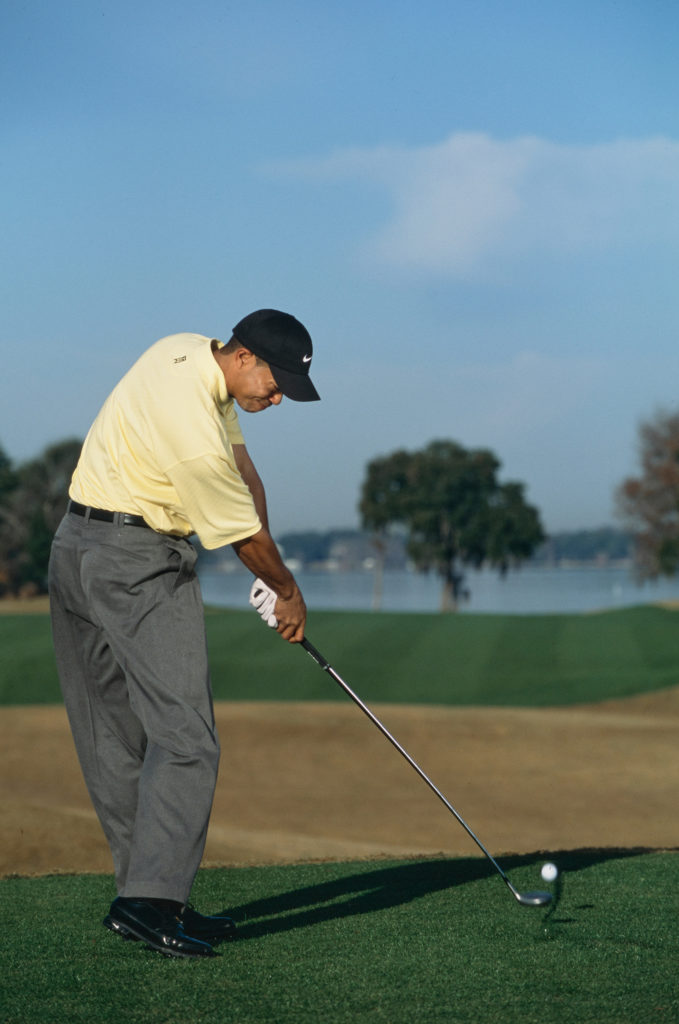
Straighten your arms for better drives
▶ Tiger says: Most amateur golfers could cure their power and accuracy problems with the driver simply by learning to extend their arms during the takeaway and through-swing. Extending on the way back and through maintains the width of the swing needed for power, and straightening the right arm in the downswing like you see here [above] helps square the clubface through impact for accuracy. Feel a stretch directly above your elbow as the club moves through the hitting area.
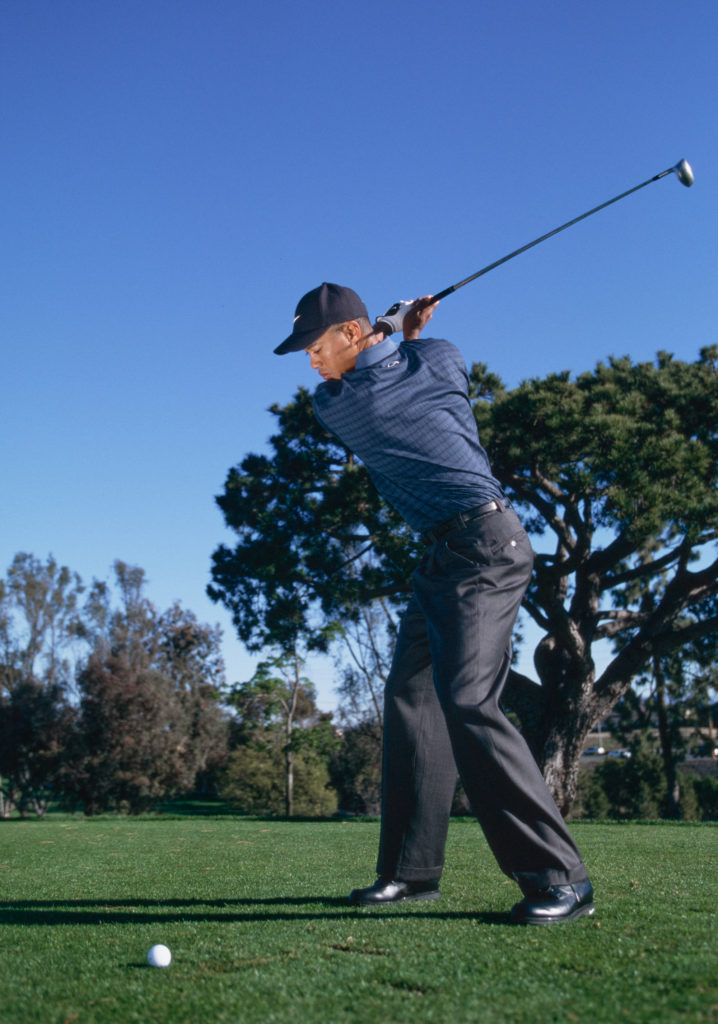
Put yourself in position to bomb it
▶ Tiger says: One of my most important swing thoughts is, Wide at the top. For me, what that means is, I like to feel that I’m pushing my left arm away from my head while pointing my left elbow at the ground. That helps keep my clubface square at the top of my swing and puts me in position for a powerful downswing. When I reach the top fully loaded [above], I just let my arms and hands fall naturally back to the ground as I rotate my body towards the target. The clubface returns to the ball squarely.
Launch it higher to hit more greens
▶ Tiger says: There are times when the only way to hold a green or get it close to a tucked pin is to hit a higher approach shot. How? Play the ball slightly forward in your stance to give the shot added height. Align your feet and body to allow for a little fade to the shot shape, then take the club back and through on the line of your feet. Don’t let your arms release as much as normal through impact [near right], and limit the rotation of your wrists. My right arm extends down the target line through impact and does not finish as much [above right] as it does for a lower draw.
To draw it or fade it, change your release
▶ Tiger says: There is more than one way to curve the ball – a lot of it can be controlled at setup – but how you release the club through impact is super important. For a fade, the swing path should be a little more outside on the backswing and inside the target line after impact [above left]. Limit the release of the club through the shot, keeping the toe of the club from turning to the left. For a draw, it should feel like you’re swinging really in to out on the through-swing with your right arm rotating over your left [above right].
How to sync your swing
▶ Tiger says: Think of your swing as a marriage between the upper and lower body. If one dominates, the entire relationship suffers. Synchronising the swing is a matter of sequencing. I try to swing the club back with everything – hips, shoulders, arms and hands – working together. On the way down, I try to swing my arms first and hold my hips to reduce their activity. When I get to this point in the downswing [above left], my right arm tucked in to my body, I then max out the movement of my arms and lower body coming through the ball.
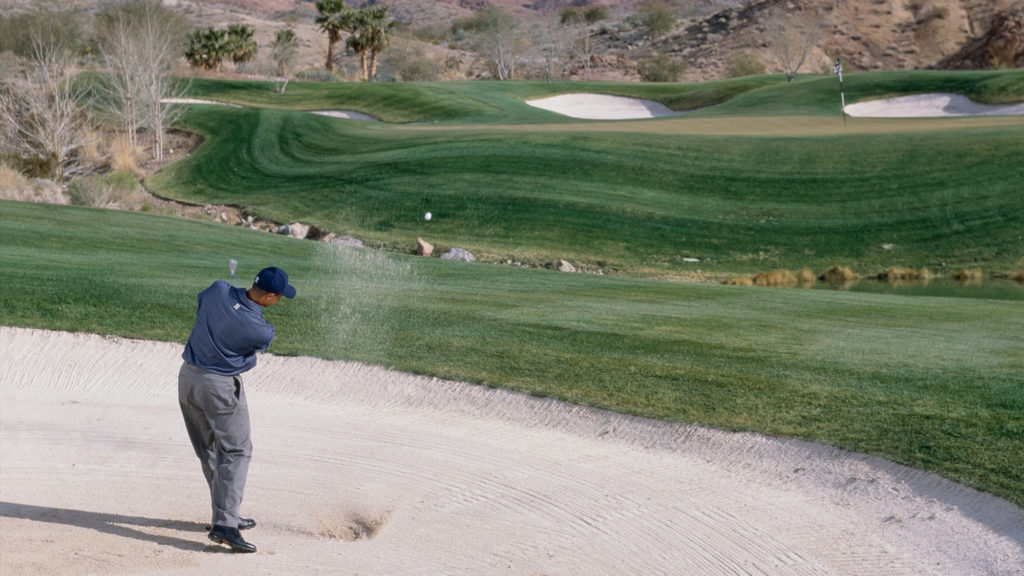
Adjust your posture for cleaner strikes
▶ Tiger says: Standing tall helps you clip the ball in fairway bunkers without taking much sand – you hit it a bit thin, something great bunker players like Mark O’Meara and Jack Nicklaus seem to do every time. They stay very level throughout the shot. I also like to play the ball towards the middle of my stance, which promotes ball-first contact. I’ll use half to a full club more than normal, dig my feet in the sand, and choke down a similar amount. The ball flight tends to be a little lower [above], because I’m trying to hit it thin.
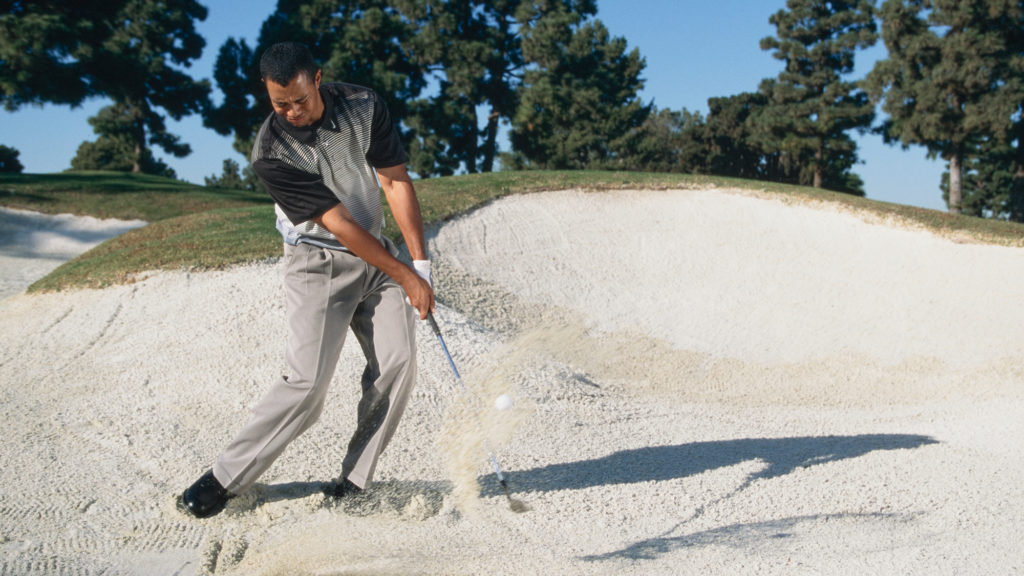
Go on the attack in greenside sand
▶ Tiger says: One of the weakest parts of my game when I first came on tour was my bunker play. What I learned was to be more aggressive with these shots. I position the ball towards my forward foot and concentrate on a spot behind the ball where I want the club to enter the sand – the closer to the ball, the more spin I can impart. The key is to weaken my left-hand grip. That lets me use my right hand aggressively. I can cock the club quicker, get the clubface more open and throw my right hand at the ball [above]. The ball lands softly with less roll.

Stay level and keep moving when you chip
▶ Tiger says: Golfers who consistently get up and down have two things in common: good posture and great technique. When it comes to chipping posture, the key is to avoid the extremes of standing too upright or bent over. When you swing, keep your head level as your knees rotate slightly. Your spine angle at impact should mirror that at address. Also, all good chippers let the club, not the hands, do the work. I keep my head still and my lower body quiet. Make sure your body, hands and arms continue through the shot [above].

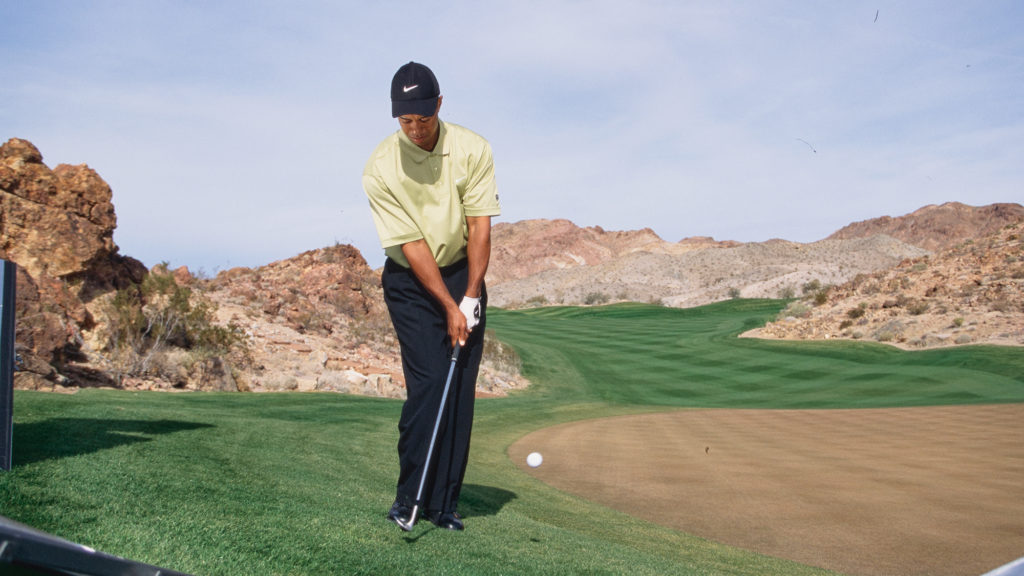
Swing along the slope for this tough chip
▶ Tiger says: Faced with a downhill lie just off the green, use a lob wedge to counter the slope and position the ball well back in your stance to promote ball-first contact. Another key, tilt your shoulders so that they are parallel to the slope. Set your weight on your forward foot, start the swing with your shoulders, hinge your wrists, then swing down the slope. Note that the clubface is still square to the target in my follow-through [above]. The clubhead has not passed my hands, and the toe has not turned over.

Bump greenside shots with a wood
▶ Tiger says: I learned this shot at the 1996 US Open and have used it to hole many chips when the ball is in the rough or fringe just off the green. It works so well because the clubhead provides the extra pop to get through the higher grass and immediately gets the ball rolling on the green for better control. A key is to keep the left arm fairly straight but relaxed through the stroke. Grip down on the club with your palms facing each other, and use your wrists to pop the clubface into the ball [above]. The ball will initially hop, then it will coast along the grass.
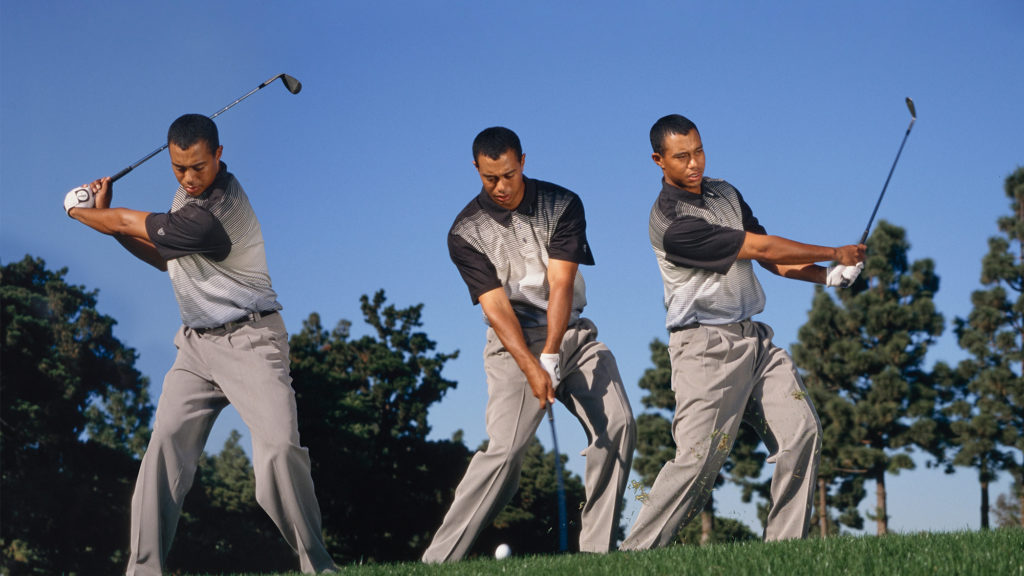
Float the ball to get at a tight pin
▶ Tiger says: I play a flop shot a little different than most. I try to hit the ball as close to the toe of my 60-degree wedge as possible. That adds trajectory and deadens the ball. I can swing as hard as I want, and the ball goes just a few yards. To flop it, set up in a wide stance and open to your target, and grip the club lighter than normal. On the backswing, pick the club up steeply and cup your left wrist [above right]. Using an active right hand, try to slide the toe area of the clubface under the ball and follow through – don’t cut short your finish.
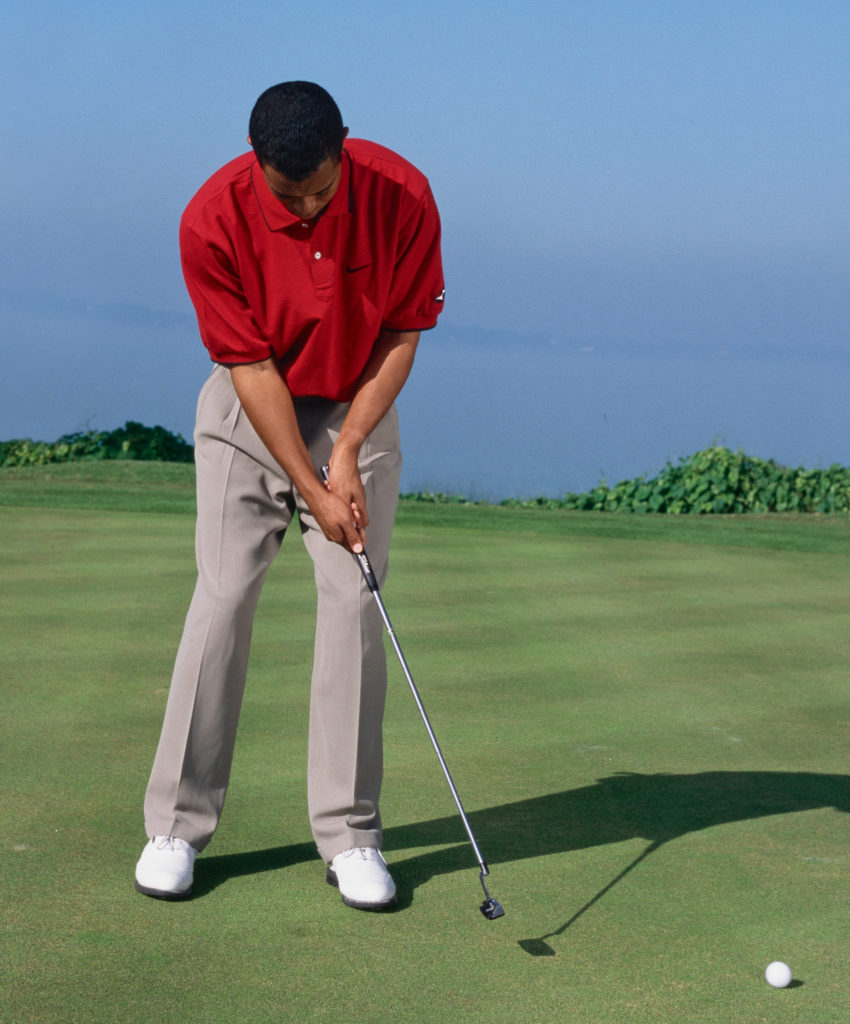
Allow for some wrist play when you putt
▶ Tiger says: Many amateurs think they’re supposed to use only their shoulders when putting, but your wrists are important. A good stroke begins with a light grip – about a 5 on a scale of 1 to 10, and both wrists should hinge slightly on the backstroke. On the forward stroke, I allow the putterhead to release with wrist hinge [left] so that it finishes well ahead of my left side. The key is to let the putterhead swing unforced. If you’re too mechanical, you’ll restrict the release and roll the ball inconsistently.
Get the big picture, then narrow focus before putting
▶ Tiger says: During the pre-putt routine, your brain must be a computer, quickly assessing all the factors involved, like the influence of grain, water and mountains in the distance and the speed and elevation of the green. The key is to repeat this routine every time – that’s why they call it a routine. After I replace my ball, I get a good overall view from behind the ball, then I walk to the hole on the high side to determine slope and speed. On the way to the other side, I check the direction of the grain and then confirm my read on the low side, still feeling the slope with my feet. Finally, I give it one more look behind the ball, sometimes using “tunnel vision” [above right] to really focus on the line. Then it’s time to putt.



